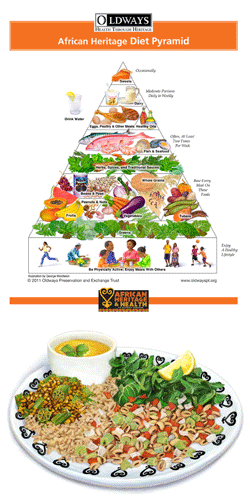Food pyramids are the perfect tool for depicting total diet at a glance. Done right – with colorful, enticing images of real foods – food pyramids show examples of what to eat over time (not just at this one meal!) and the relative proportion of each food group.
Pyramids, Plates and Real Food
At Oldways, we’re convinced that good dietary guidance has three important elements: pyramids, plates and real food.
Real food is most important. The theory of good nutrition makes people’s eyes glaze over, but a plateful of well-prepared healthy food rules the day. Not sure you like whole grains? Try my bulgur pilaf, and I’ll make a believer of you. Can’t stand the taste of bland, over-steamed vegetables? I’ll cook up the same veggies with a little olive oil, onion and herbs, and you’ll ask for seconds. If I can’t actually cook for you, I’ll show you pictures that will convince you to eat well.
Plates are important too. The well-balanced plate is more than just one dish. A healthy plate, heaped with vegetables, whole grains, and perhaps a little fish or some beans, stands in sharp contrast to the steak-house ads where red meat covers two-thirds of an oversize platter. We create “Plates of Expression” — showing real foods — to complement our Heritage Pyramids.
Still, there’s no substitute for a good pyramid when it comes to showing a balanced, total diet. Pyramids show the combination of all our meals over days or weeks, not just one plate, demonstrating a clear, long-term path to better health.
That’s why Oldways uses all three of these important elements:
- Pyramids, for the big picture
- Plates of Expression, for meal-by-meal ideas
- Real food, everywhere, to remind us that delicious and healthy go together

